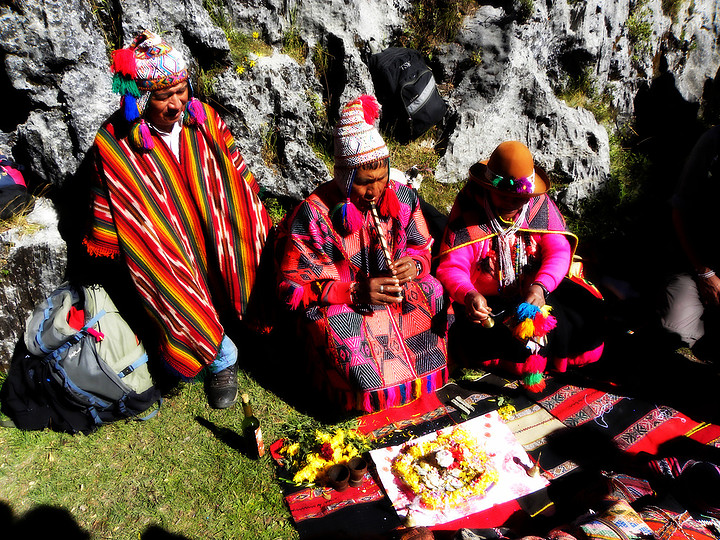In this week’s blog, I’m going to be discussing the history of the Q’ero people and how they came to inspire the shamanic Medicine Wheel training.

The Q’ero for Newbies
Who are the Q’ero?
The Q’ero people live in villages in the clouds between 11,000 and 14,500 feet in the mountains of Peru. They are often referred to as the ‘last of the Incas’ because they still dress, converse and live, much as the Incas did.
They are believed by many shamanic practitioners to be the keepers of an energy medicine, which, because of their uniquely isolated residences, has changed very little since the time of the Incas.
Is theirs the shamanic path that you follow?
I am fascinated by the much wider embracing of shamanic practices from across the world, known as ‘core shamanism’, as originally espoused by the anthropologist, Michael Harner. My particular interest in this pathway is shamanic journeying.
However, I am also a certified mesa carrier in the narrower Q’ero Incan tradition, having undertaken the Medicine Wheel with the Spirit of the Inca group three times (to date). My particular interest in this narrower pathway is the rites of the Munay-Ki (see my previous blog post, Munay-Ki for Newbies and my recent book, Journeying Through The Munay-Ki), which are predominantly drawn from the rituals of the Q’ero people.
Why weren’t the Q’ero just assimilated into the Spanish Empire after the conquest of the Incan Empire?
The answer is both geographical and a little bit of shamanic magic.
The story of how Francisco Pizarro and just 168 of his Spanish conquistadors defeated the Inca, a nation of millions, is an extraordinary one.
Plague and the civil war between Huáscar and Atahualpa, the sons of the last Sapa Inca, had weakened the Incan Empire. Pizarro managed to kidnap the victor of the civil war, Atahualpa, and ruled through him for a while, before extracting a vast ransom of gold and silver. Having got what he wanted, Pizarro then had Atahualpa executed by garrotte. Pizarro’s professional soldiers then proceeded to systematically defeat the demoralised Incan armies. The Inca Empire was, thus, overthrown and, South America, forever changed.

But the Q’ero weren’t changed by this?
The secret of how the Q’ero were untouched by this great ‘overturning’ is covered in the little known story of the Battle for Q’ero:
The legendary Altomesayoq, Garibilu Q’espi, alerted the villagers of Wiraquchapampa to the imminent arrival of the conquistadors. The villagers duly fled into the mountains, leaving no food or water for the exhausted conquistadors.
Consulting with the Apus, the mountain spirits, Q’espi was told to build a ‘saiwa’, a sacred column of stones. The saiwa was then struck by lightning – the rocks fell and crushed many of the conquistadors who, unnerved, never returned to the area.
So, ancient medicine was preserved in the Q’ero villages in the clouds?
That’s right. Left unmolested by the conquistadors, it is claimed that certain Incan traditions were uniquely preserved by the Q’ero, amongst them, some of the rites we now collectively call the Munay-Ki.

How has this medicine arrived in the West?
Much of our knowledge and understanding of the Munay-Ki is owed to Alberto Villoldo, an anthropologist who lived amongst and trained with Q’ero paqos and who subsequently played a key role in bringing their rituals and prophecies to the attention of the modern world. He offered them to his students, with the permission of his teacher, Don Manuel Quispe, who was widely regarded as the last of the great medicine men of the Q’ero Inca.
How does Q’ero medicine work?
The Q’ero believe in the concept of ayni – an exchange of energy between humans, nature and the universe. Thus, it is said that to live in ayni, is to live in balance and harmony with the world.
Finding balance can be achieved by manipulating a person’s Luminous Energy Field. This is similar to the concept of the aura, which is familiar to most New Age practitioners. However, Alberto Villoldo claimed that the Q’ero utilised, ‘a nearly forgotten Inca practice for healing through the Luminous Energy Field’ (Villoldo, 2000, 1), long before it’s popularity in the New Age movement.
Is it ‘energy healing’?
Yes. By working on a person’s Luminous Energy Field, that is, at the energetic level, healers in this tradition seek to affect the spiritual, mental, emotional and physical bodies of their clients, rather than ignoring one aspect, or laboriously taking each in turn.
This can be a little concerning if we are used to modern western medicine, which tends to only utilise one aspect of our bodies to heal us – such as employing pharmaceuticals (physical) or counselling (mental).
It is beautiful work and I would certainly encourage you to experience it for yourself.


